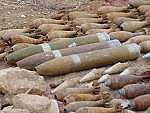EAPC workshop on clearing explosive remnants of war (ERW) with a focus on cluster munitions
The residual effects of war can impede efforts to reconstruct civilian infrastructure for many years after the conflict. All too often, large areas needed for civilian purposes are found to be strewn with unexploded cluster bomblets and other forms of ERW as a result of former military activity. Such concealed dangers represent a hazard to all who live and work on such land. They can kill and maim indiscriminately and thus present a significant challenge to post conflict development and human security.

Unfortunately, the clearance techniques and technologies needed to successfully render these regions safe again, can be costly and often require high levels of expertise. Consequently, many nations are seeking assistance in clearing areas contaminated with ERW, due to the special requirements associated with this difficult and extremely dangerous process.
Additionally, it is estimated that the number of cluster munitions currently being stockpiled in eighty five countries around the world reaches several billion. As ammunition ages, it often becomes unserviceable and, ultimately, unstable. Explosions involving depots of antiquated munitions stockpiles occur on an all too regular basis in regions all over the globe, including the Euro-Atlantic area. Demilitarisation requires special expertise and technology, and ammunition containing cluster munitions presents special challenges.
These incidents cause damage to civilian habitats, often causing large numbers of immediate fatalities, annihilating infrastructure as well as littering the surrounding land with potentially fatal unexploded ordnance which can stay hidden, remaining a danger years later. It is of the utmost importance that countries stockpiling cluster munitions ensure that such stockpiles are kept safely and that these countries also have at their disposal, the capacity and means to identify and demilitarise any stocks that are considered unserviceable. As with clearance processes, the activities involved in demilitarisation are often complex and expensive.
The purpose of this Workshop is to provide a forum which can explore the ways in which such practical challenges can be addressed. The Workshop will bring together a group of highly experienced professionals, from national governments, from international organisations and from non-governmental organisations who have hands on expertise in the domains of clearance and demilitarisation projects. During the Workshop, participants will be briefed on the core issues relevant to these practical processes. There will also be the opportunity to observe a practical demonstration of clearance techniques and equipment which has been organised in collaboration with the Belgian Ministry of Defence, who have agreed to take participants to a nearby military base for this purpose.
Through sharing experiences, exchanging information and discussing best practices, the Workshop on Clearing ERW with a Focus on Cluster Munitions aims to open new lines of communication whereby new possibilities for assistance pertaining to the clearance and demilitarisation of cluster munitions may be developed.
For further information, please contact Miss. Erin DE GLANVILLE Tel: 0032 2707 7002, e-mail: deglanville.erin@hq.nato.int, Mr. Kent JAMISON Tel: 0032 707 4968, e-mail: jamison.kent@hq.nato.int or accs@hq.nato.int and/or via facsimile: 0032 02 707 4140.
